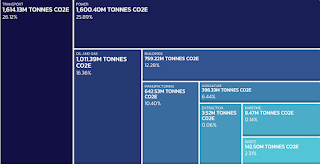
First to all of you who participate in Contrary Brin’s lively and very smart comment community…one of the oldest and best on the web… see a housekeeping comment below.
Ever since I wrote Earth, way back in 1989, I’ve long held we should emulate some of nature’s own processes and help her to ameliorate the harm we’ve done with our ignorance and adolescent greed — including now the notion of a worldwide campaign to ‘plant a Trillion Trees.’ Does it count for my predictive tally that a Trillion Trees Campaign was later proposed in 2011? Or that the World Economic Forum in Davos endorsed it in 2020?
But let’s correlate that with something in the news about geoengineering. If it is acceptable to help the planet by planting billions of trees, how is tree planting any different inherently than proposed efforts to stir bottom sediments into fast ocean currents, thus fertilizing them and bringing alive some of the 70% of the oceans that are ‘deserts’ almost barren of visible life?
This could exactly emulate how Mother Gaia creates the vast life-fecundity off the Grand Banks or Chile or South Africa, that both feeds hundreds of millions and pulls carbon from the air.
“In 1990, the oceanographer John Martin proposed that the Southern Ocean is starved of iron, and that deliberately seeding its waters with the nutrient would allow phytoplankton to grow. The blooming plankton would soak up carbon dioxide, Martin argued, and cool the planet and slow the pace of global warming. Researchers have since tested this idea in 13 experiments, adding iron to small stretches of the Southern and Pacific Oceans and showing that plankton do indeed flourish in response.
“Such iron-fertilization experiments have typically been billed as acts of geo-engineering—deliberate attempts to alter Earth’s climate. But Savoca and his colleagues think that the same approach could be used for conservation. Adding iron to waters where krill and whales still exist could push the sputtering food cycle into higher gear, making it possible for whales to rebound at numbers closer to their historical highs. “We’d be re-wilding a barren land by plowing in compost, and the whole system would recuperate,” says one oceanographer.
== Climate Change ==
But of course, almost all of our enlightenment problem solving systems are currently clogged by the great big, worldwide putsch to re-establish varied forms of feudalism.
== A changing climate ==
Micro-plastic fragments swirling in the atmosphere may be influencing the climate – scattering and absorbing sunlight.
The American bumblebee has vanished from eight U.S. states – and could now qualify for protection under the Endangered Species Act.
UCSD researchers have identified a correlation between extreme heat in low income countries and increased incidence of stillbirths and preterm births.
And.. rising waters: The volume of the downpour during one hour in Zhengzhou, which flooded subways and killed scores of people, exceeded anything in 5,000 years of recorded Chinese history. Hundreds were killed in Germany by rivers surging to levels not seen in 500 or even 1,000 years. And for the first time, temperatures hit 121 degrees Fahrenheit in the normally cool climes of Canada, while it’s snowing in Brazil.
The western drought is unprecedented. The fit is hitting the shan. And in the southeastern US, which will experience the nation’s guaranteed worst outcomes, from malaria to the worst loss of land to rising waters… denialism is becoming frantic. Open war vs. all fact professions. Plus frenzied “prepper-survivalist” notions of “If then end’s a-comin’ then bring it!”
Sure, it could lead to Holnism, (from The Postman.) But what’s scariest is something I predicted back in the 1980s and 1990s… that all of this will lead to literal millennialism. A mania in the early 2030s around the supposed 2000th Easter. It will happen, so we better sane-up before that.
What can you do? Well some of you might consider: above and beyond mere politics… if you seriously want to help civilization be resilient against shocks the future might bring, consider (in the U.S.) taking training for CERT – your local Community Emergency Response Team. It’s a really interesting and fun 20 hour course given by your local fire department and you get cool green equipment and a badge! And once a decade maybe some light duties to help keep your family and neighbors safe.
Then there is this detailed interview I gave about half a dozen ways that small investments could make us much more resilient… what we should have done… and can still do… to help our nations, civilization and families be more robust against the batterings of fate.
== A twin Earth? ==
Knowledge is power. One step toward climate accountability: Climate Trace compiles satellite observations to monitor global emissions from agricultural, manufacturing, transportation, and oil and gas extraction sectors. For instance, a snapshot of the CO2 emissions of the United States appears at right.
== A story of resources ==
“This past year, the world’s biggest jeweler Pandora announced it will cease to sell all mined diamonds (which are scarce and fraught with environmental and human rights abuses), and switch exclusively to selling lab-made diamonds, which can be abundant and low cost—produced from water, methane, and electricity.”
There are few oligarchic-monopolistic conspiracies more evil than the DeBeers diamond cartel. So this is potentially great news, brought to you by advancing technology.
Though he starts with the story of aluminum.
—-
Housekeeping note. I’ll switch back to allowing anonymous comments for just a few days, to see if any of the regulars in our comment community were locked out, when I switched to requiring a Google sign in. If that requirement locked you out, this is your chance to speak up. But the spam bucket was empty, last I checked. So we’re likely to make the change permanent.

